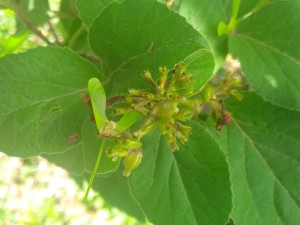
I love the moment in spring when all the flowering trees and shrubs seem to burst into simultaneous bloom. Depending on the weather, that mass flowering can last a few days or more than a week. It always ends in showers of petals that rival the snow flurries we had up until about three weeks ago.
The Korean spice viburnum or Viburnum carlesii graces my back garden was part of that spring flower extravaganza. Now most of its blooms have drifted away, but traces of its magnificent fragrance—among the best in the floral world—linger.
A few years ago I first caught wind–literally–of the fragrant flowers of Viburnum carlesii, also known as Korean spice viburnum. The scent is intensely sweet and pervasive, with just enough clove-like notes to keep it from being cloying. After just a few minutes in the presence of this medium-size shrub, it became my latest horticultural heartthrob and I was ready to put everything on hold until I got one of my own. As is often the case, I had no idea where I would put it, but such mundane concerns did not stop me. Had I discovered that Viburnum carlesii grew to mastodon-like dimensions and was available only on Guam, I would still have made every effort to find one. That is the nature of obsession and the allure of this fragrant viburnum.
Fortunately, the shrub was relatively easy to obtain and has never approached mastodon size. My ten-year old specimen, which I have trimmed into standard or tree form, is now about six feet tall and three feet wide. It would probably be bigger still, but it was clobbered by a giant limb earlier in its life, requiring the removal of quite a few damaged branches. I keep it in bounds by pruning after bloom time is over.
The shrub’s moment of glory begins in March or April, depending on climate conditions, when it sprouts rounded clusters of dark pink buds. These open into three inch-wide snowballs packed with scores of five-petaled white blossoms. When my Viburnum carlesii is in bloom, I can smell it from at least six feet away. The fragrance intensity is similar to that of hyacinths–one snowball is enough to perfume an average room indoors. Two or more exude too much fragrance for all but very large confined spaces. I usually position one cut blossom in the foyer of my house so I can smell it upstairs and downstairs, and visitors catch the scent the moment they walk in the front door.
Lovely and fragrant as they are, the blooms do not last forever. When not in flower, the shrub is still good looking, getting by on its ovoid, two-inch long green leaves, which often turn dark red in the fall. The berries change from red to black late in the season, but are not as prominent or attractive as those on some other viburnums.
The most compelling reason to buy a Korean spice viburnum is the spring scent–but it is reason enough.
Viburnum carlesii was named for an Englishman, William Carles, a member of the British Consular Service and amateur plant collector in the late nineteenth century. Maggie Campbell Culver, in her wonderful book, The Origin of Plants, mentions that Carles collected specimens in Korea in 1883-1885, which is when he must have obtained the shrub that was named in his honor. The species was first described by English botanist William Botting Hemsley, who had a long career at the Royal Botanic Garden at Kew, ending up as Keeper of the Herbarium and Library. He was the author or co-author of many plant books, including the ambitiously-titled, An Enumeration of All the Plants Known from China Proper, Formosa, Hainan, Corea, the Luchu Archipelago, and the Island of Hong Kong; published in 1887. Presumably this is where he first described Korean spice viburnum.
Anything as fragrant as this viburnum was bound to catch on fast, especially in late Victorian and Edwardian England where the nose-wrinkling odors of wet wool and rising damp sometimes predominated. By 1907, Viburnum carlesii was so popular that its likeness appeared in the well-respected Curtis’s Botanical Magazine. If it had not made its way to the United States by that time, it was soon to do so. My 1947 edition of the Wayside Gardens catalog refers to the shrub as “a great favorite.” Wayside’s cultural information is still good today: “¦hardy, easily grown and does well in light shade, as well as in full sun.” Mine is very lightly shaded by a deciduous tree, so it gets lots of sun while it is forming flower buds in early spring. The modest shade probably keeps it a bit cool in the summer, which is a plus. I mulch it before ignoring it for much of the season, but it still seems to thrive
It is no surprise the Korean spice viburnum attracts butterflies and other pollinating insects as readily as it attracts human admirers. Some sources call it “deer resistant”, but I always take such phrases with a big grain of salt. Suffice it to say that a moderately hungry deer will probably eat other plants, like your daylilies or hostas, first.
If you have a smaller garden space, you can still enjoy Viburnum carlesii by planting ‘Spice Baby’, which grows only three to five feet tall, as opposed to the eight-foot grandeur of larger varieties.
Some large garden centers and specialty nurseries probably carry Viburnum carlesii. If you can’t find one nearby, the shrub is available from ForestFarm, P.O. Box 1, 14643 Watergap Road, Williams, OR 97544, (541) 846-7269, www.forestfarm.com. Free print catalog.

